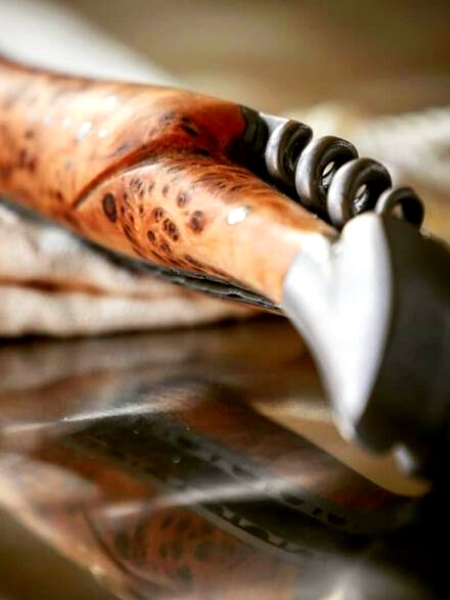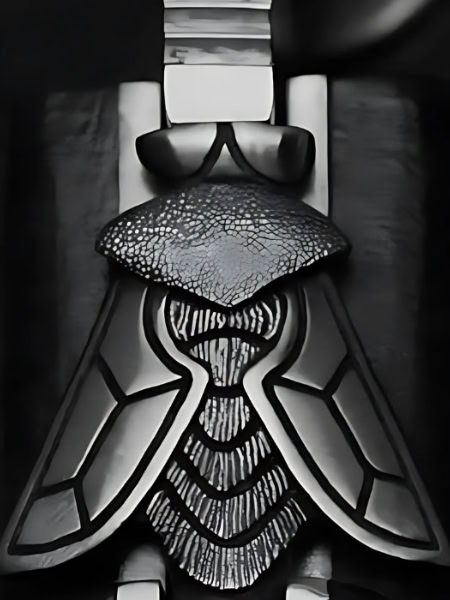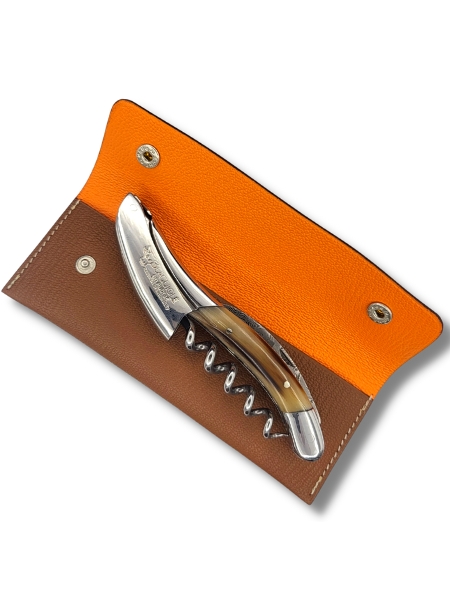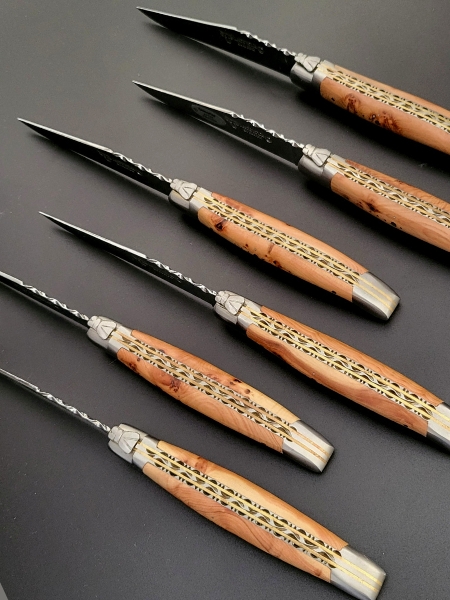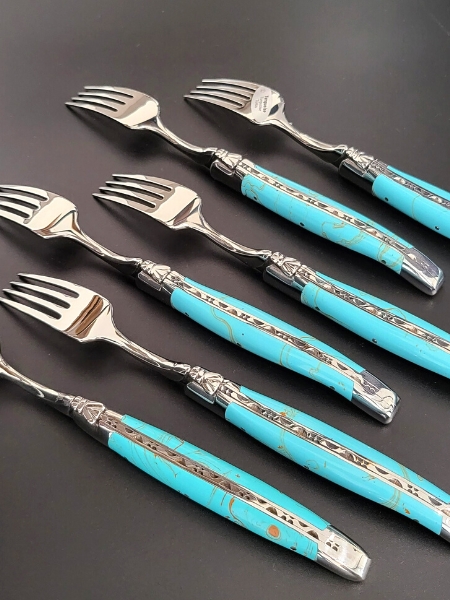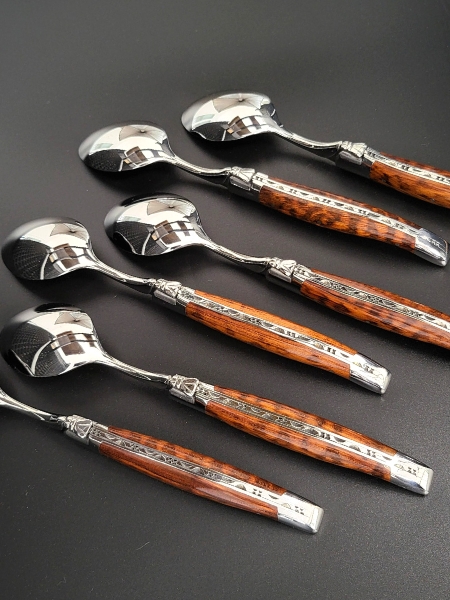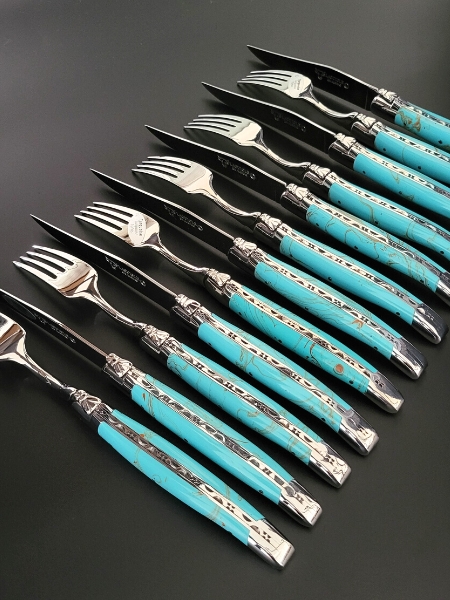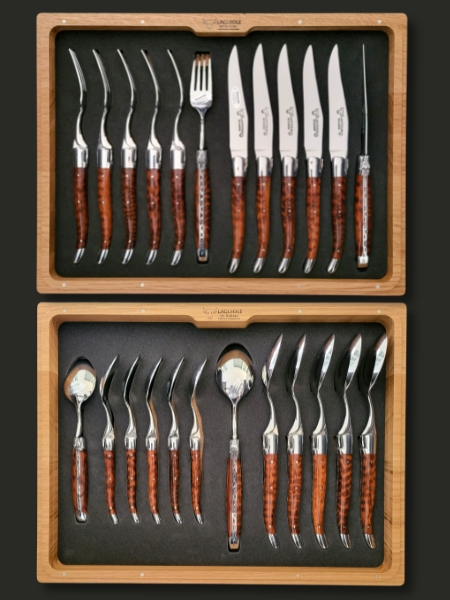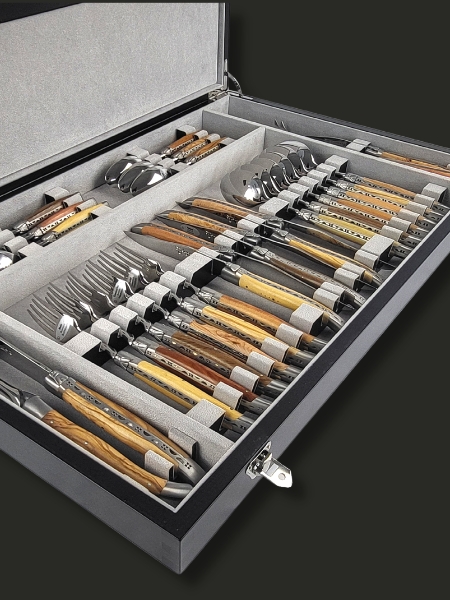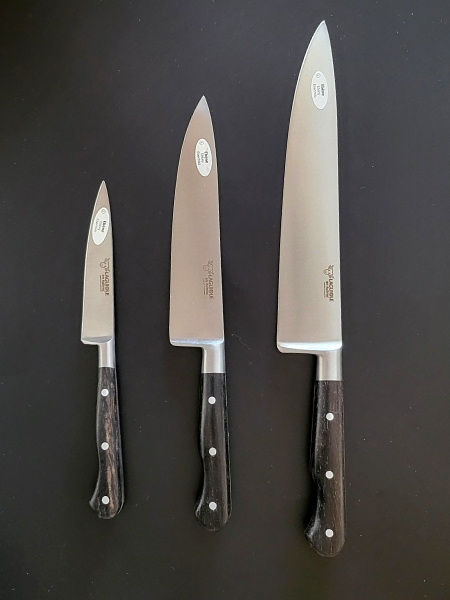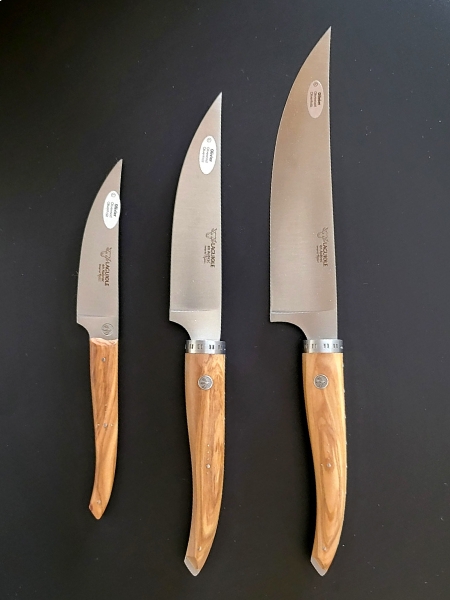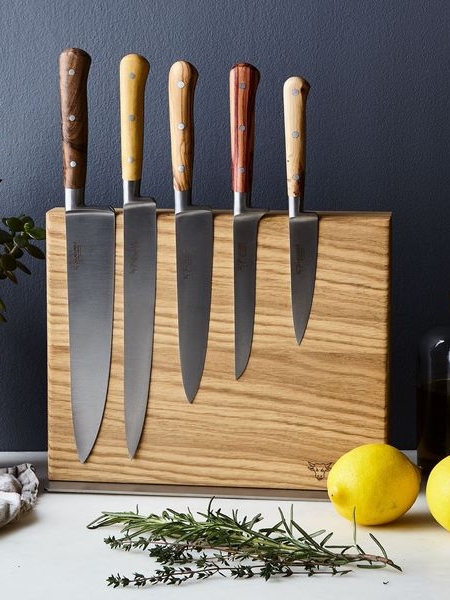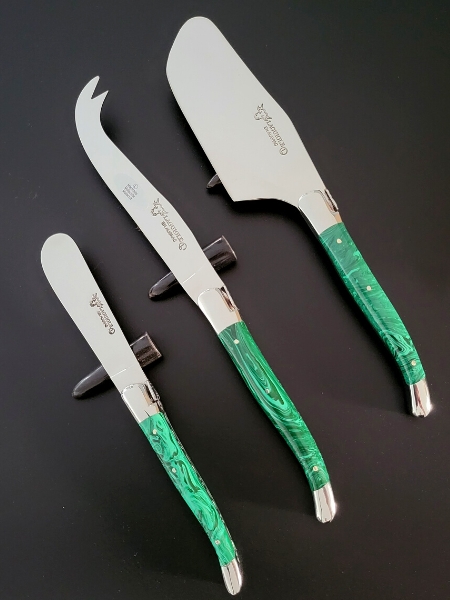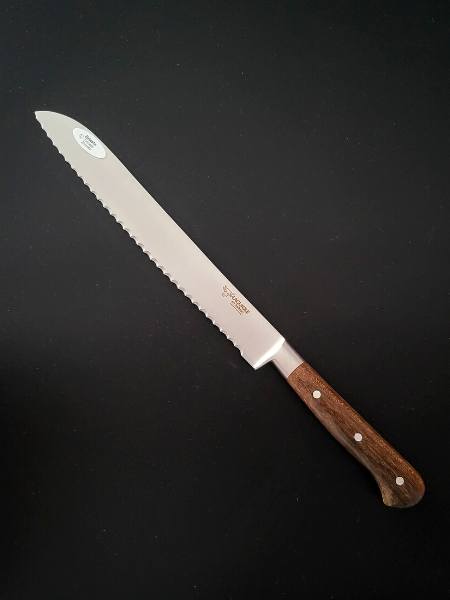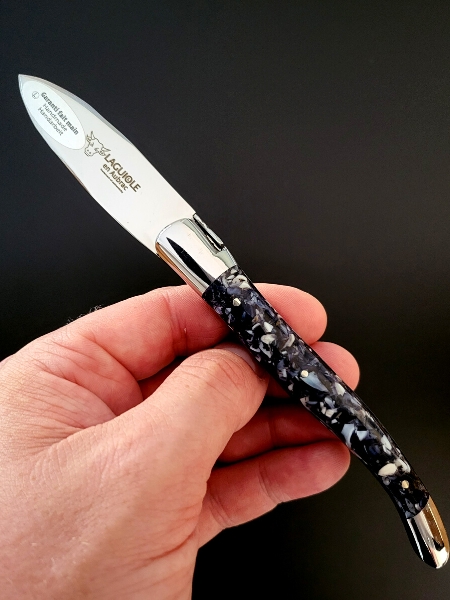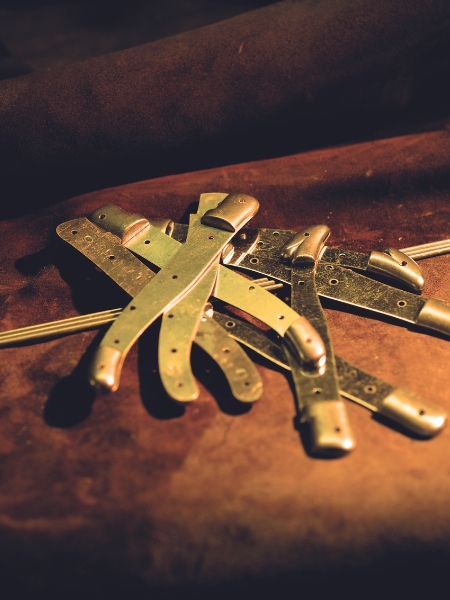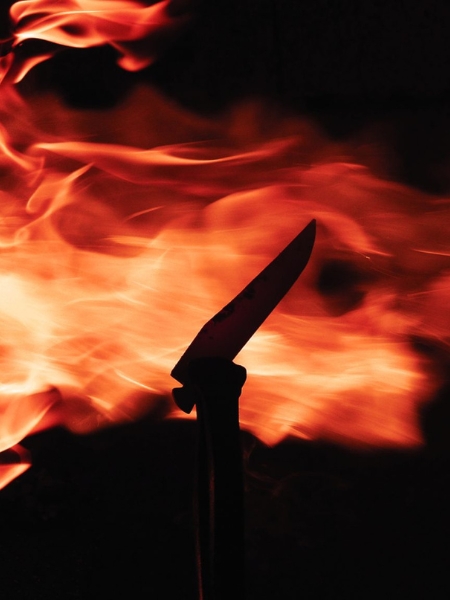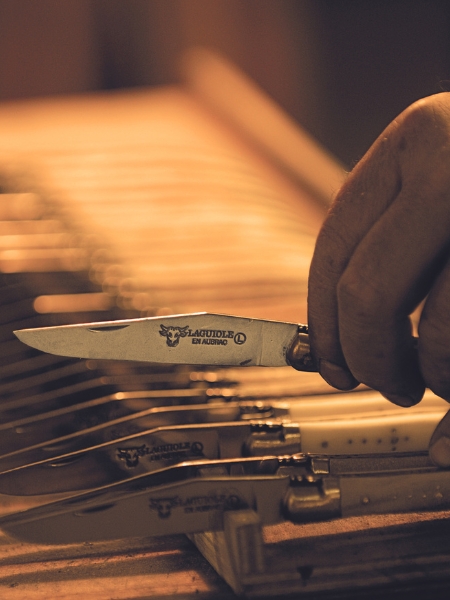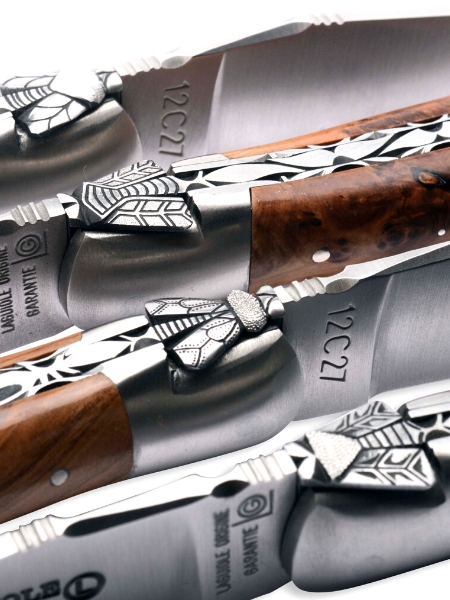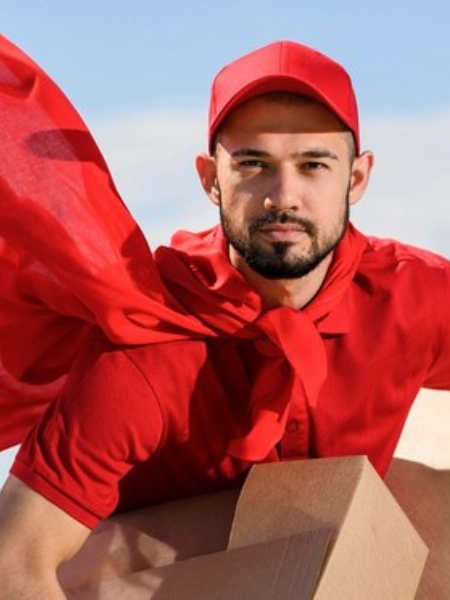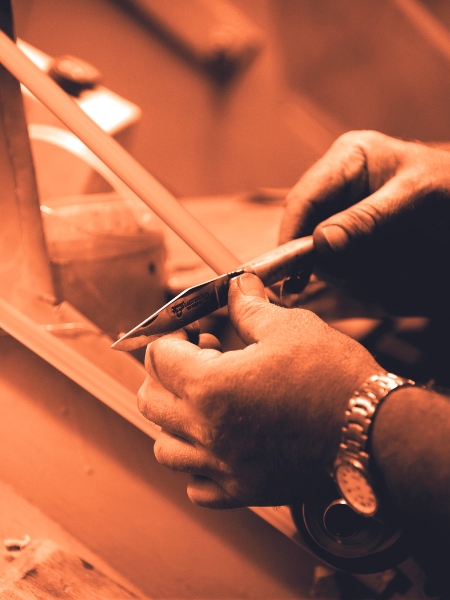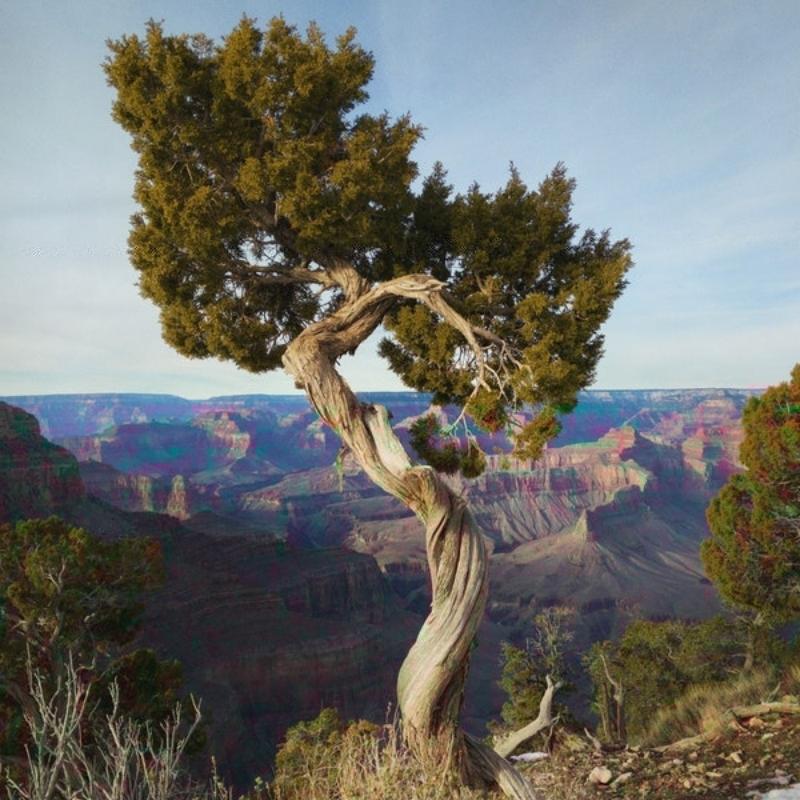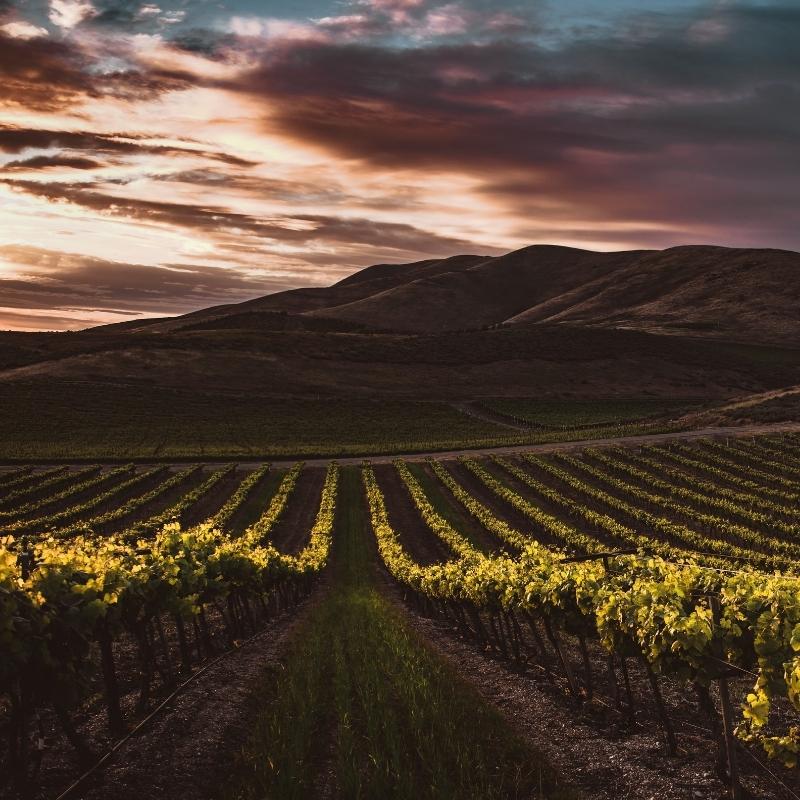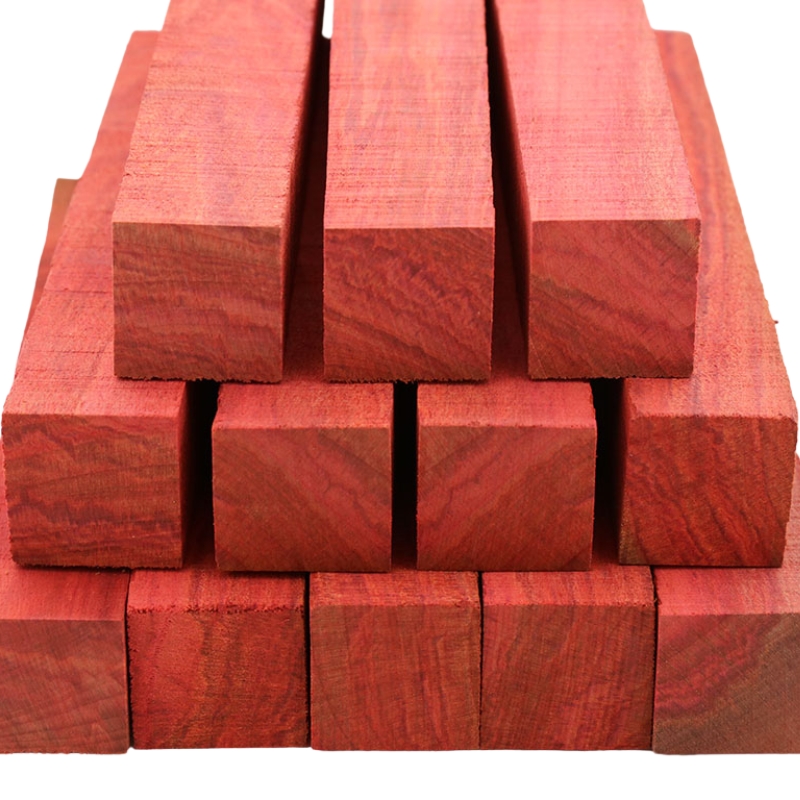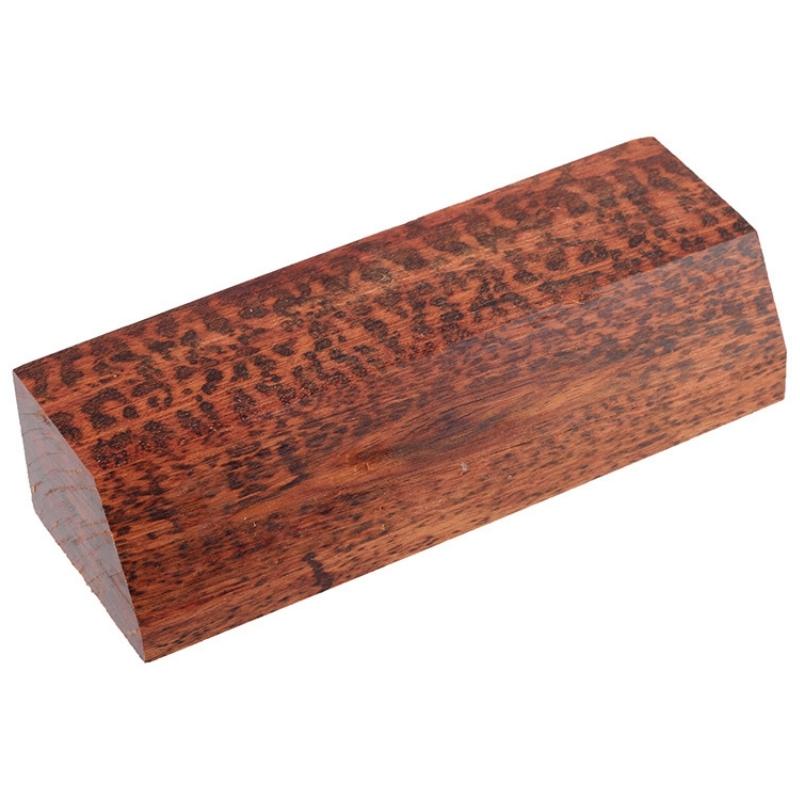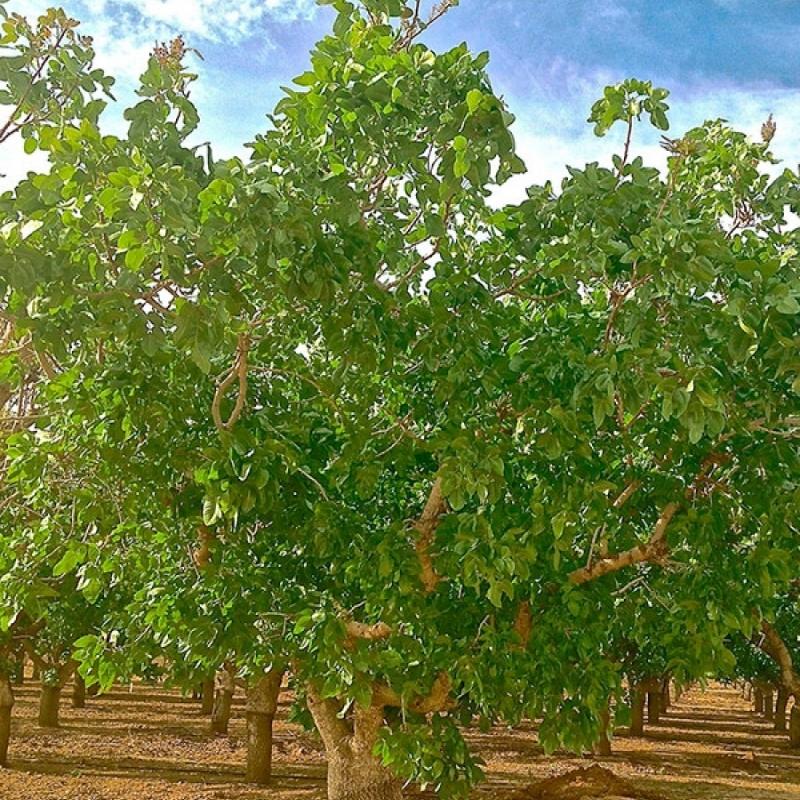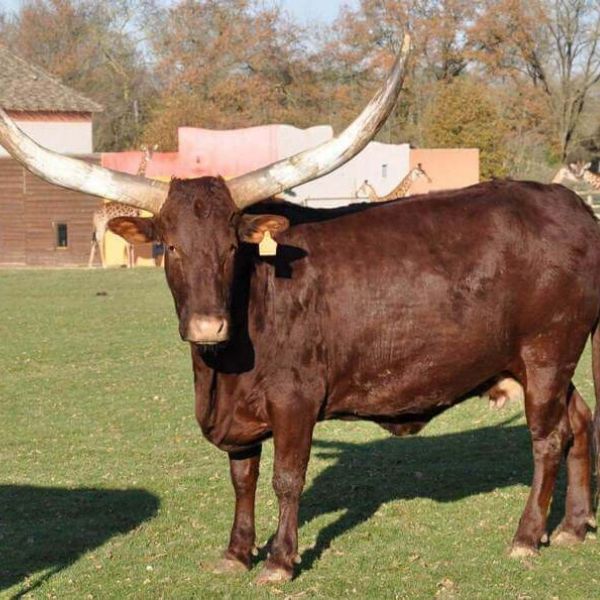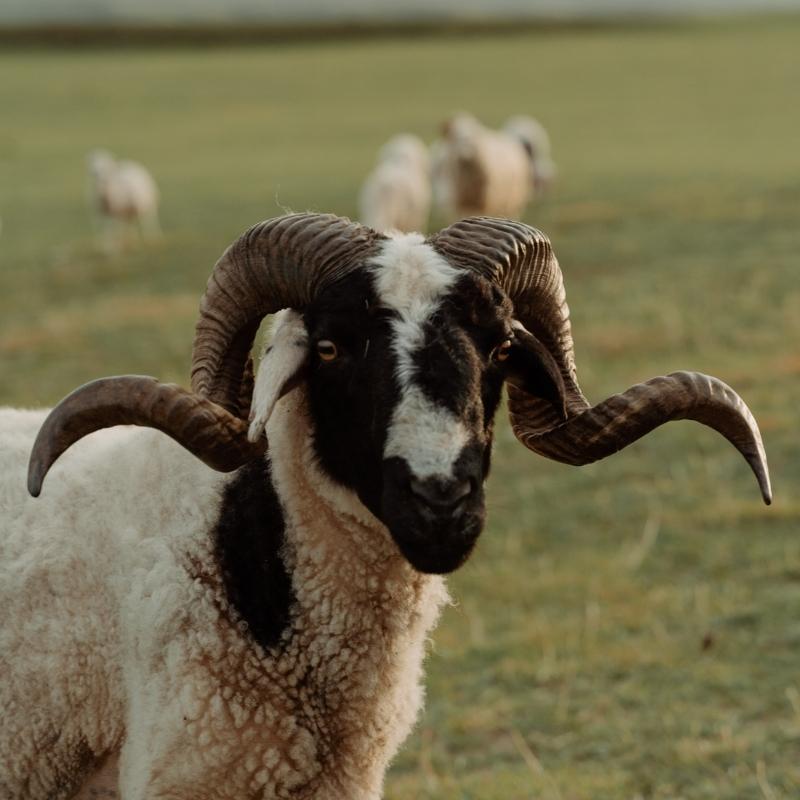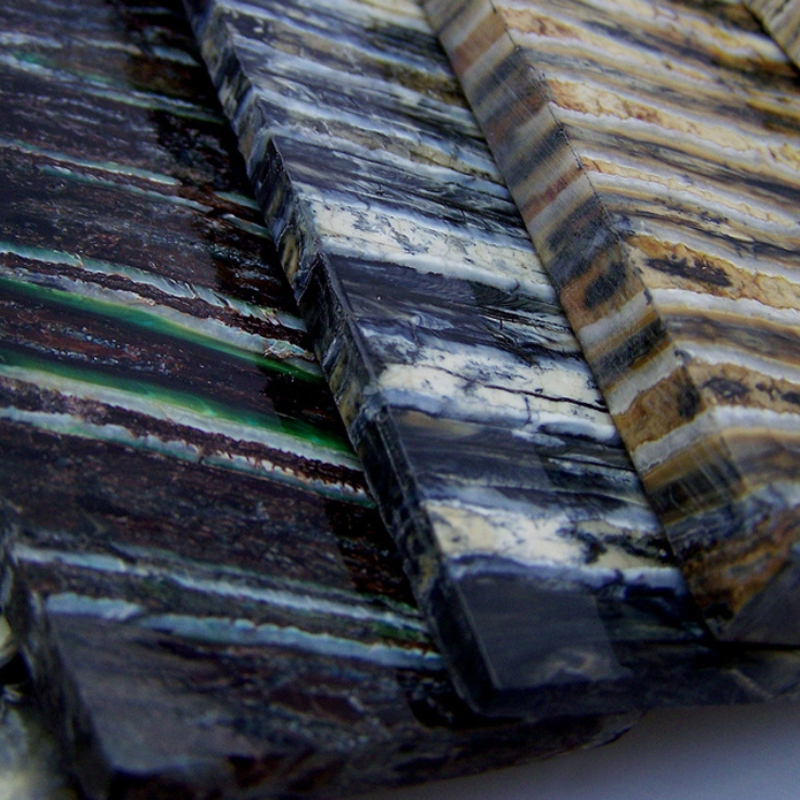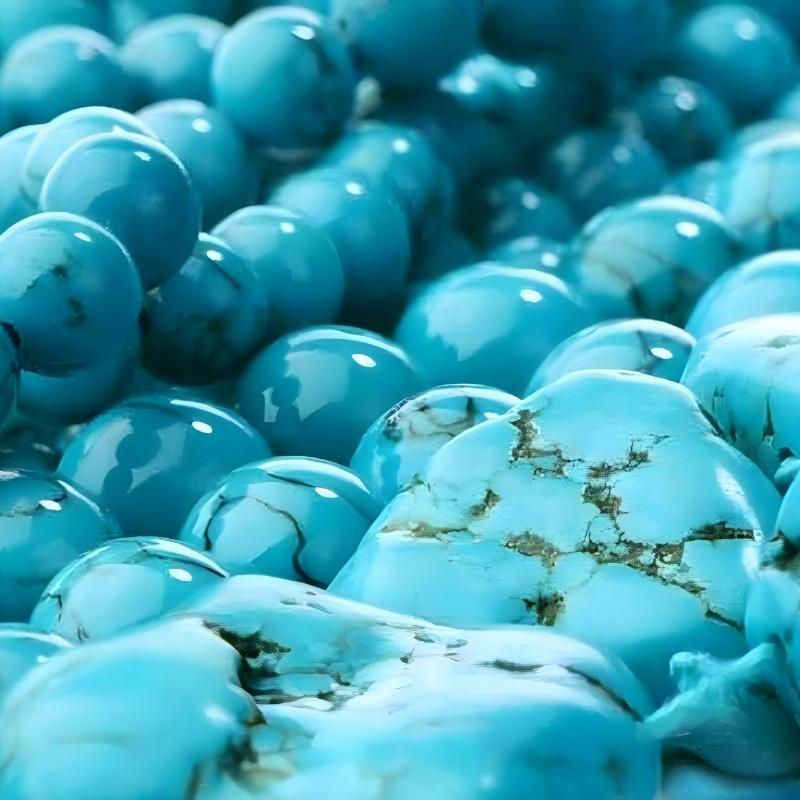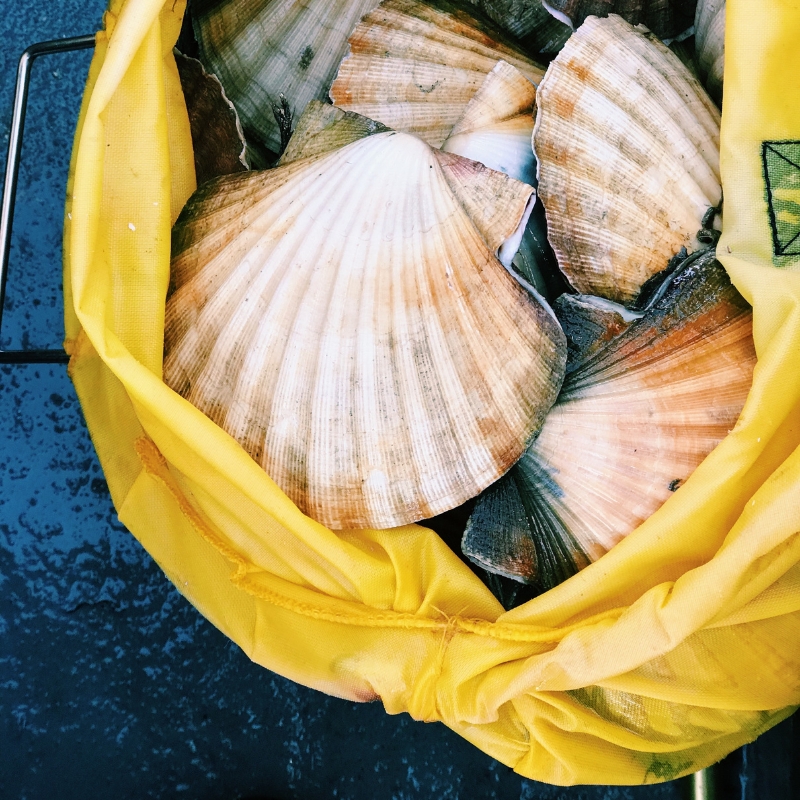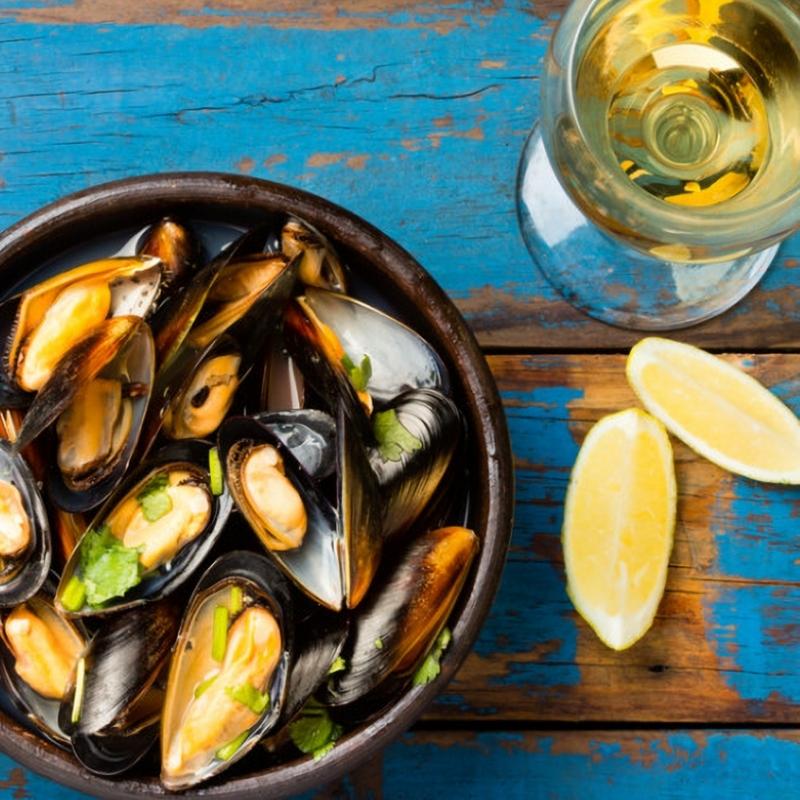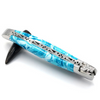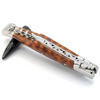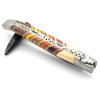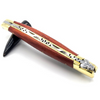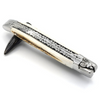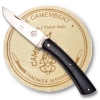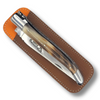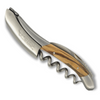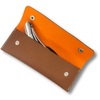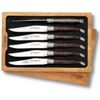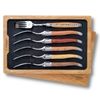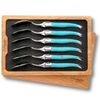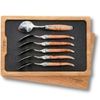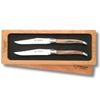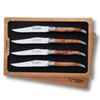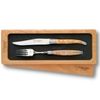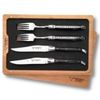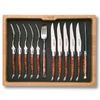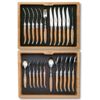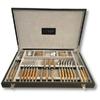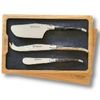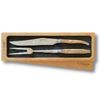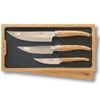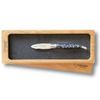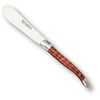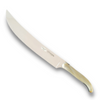
Laguiole Handle Materials:
A Guide to Choosing the Perfect Material!
With a variety of knife handle materials available, selecting the perfect one can be a challenge. Each material has its own unique characteristics, making it essential to understand their differences. In this guide, we’ll explore the properties of wood, horn, and other materials to help you make the best choice for your needs:
-
Textures and Patterns: Natural materials like wood and horn provide a range of textures, grains, and colors. Wood varieties can range from light and uniform to darker, marbled tones, while horn offers unique patterns such as stripes and spots. Both materials add elegance and character to any knife.
-
Weight: Wood tends to be lighter than horn, which can be an advantage if you prefer a lighter knife for ease of use.
-
Comfort: The choice of handle material may also depend on your comfort preferences. Some may prefer the softer, warmer feel of wood, while others might enjoy the smoother, cooler feel of horn.
- Density: When considering handle materials, density is another factor to keep in mind. Horn is generally denser than most wood types, providing a heavier and more solid feel in hand.
Ultimately, the choice between a wooden, horn, or mammoth ivory handle will depend on your personal taste, needs, and budget. Each material offers a unique aesthetic and can add sentimental value to a knife. Whether you’re drawn to the warmth and texture of wood or the durability and smoothness of horn, there’s a material to suit everyone’s preferences.
Discover a Wide Range of Handle Materials!
At the online store: laguiole.store, we offer a selection of high-quality handle materials for our knife collections. Carefully chosen for their aesthetic and functional properties, these materials cater to a variety of tastes and preferences.
European & Exotic woodsChoose from various types of wooden handles, including French, exotic, and European woods, each providing a distinct aesthetic in terms of color, texture, and grain patterns.
Animal MaterialsTraditional Laguiole knives are crafted from animal-derived materials such as horn, bone, and even fossilized mammoth tusk or molar, offering unique color and texture combinations.
Mineral materialsFor those seeking something truly unique, Laguiole en Aubrac also provides mineral-based handles, including turquoise, malachite, and larimar, offering an elegant and distinctive touch to your knife collection.

Olive Wood
Olive wood is a highly sought-after material in knife making due to its unique qualities. Originating from Mediterranean regions, it is obtained from cutting the tree at the end of its natural life. Its color ranges from light brown to dark brown, with unique veins and patterns that make it very attractive. Its texture is smooth to the touch, with fine pores and grains that add dimension to its surface.
The veining of olive wood is particularly interesting for artistic knife makers. Vein patterns can vary significantly, from soft, wavy designs to more pronounced and angular patterns. This gives artistic knife makers the opportunity to create unique designs for their blades.
Olive wood is also used in other types of crafts, such as jewelry making and sculpture. Its water and stain resistance makes it an ideal choice for jewelry, while its natural beauty makes it appealing for sculptures and art objects.
Ebony Wood
Ebony wood is a prestigious material in artisanal knife making. Native to Africa, it is obtained from several tree species belonging to the Diospyros genus. Its color ranges from deep black to dark brown, with a smooth texture and very fine pores. Ebony wood is renowned for its hardness and wear resistance, making it highly suitable for knife handle manufacturing.
The veining of ebony wood is generally uniform and regular, with very few visible patterns. This gives ebony knife handles a smooth and elegant appearance, which is highly appreciated in artisanal knife making. The density of this wood is also remarkable, making ebony knife handles particularly heavy and solid.
Beyond knife making, ebony wood is also used in other types of crafts, such as marquetry, sculpture, and high-end furniture making. Due to its natural beauty and durability, ebony wood is often considered a symbol of luxury and prestige.
Juniper Wood
Juniper wood is a popular material in artisanal knife making for its beauty and durability. Native to many regions of the world, it is obtained from the juniper tree, which belongs to the conifer family. Its color ranges from light brown to dark brown, with a smooth texture and fine pores. The veining of juniper wood can vary greatly, from a uniform appearance to more pronounced and complex patterns.
Juniper wood is a popular choice for knife handles due to its peppery smell. Due to its hardness, it is also easy to work with and allows artisanal knife makers to create customized and unique knife handles. Outside of knife making, juniper wood is also used in furniture making, cutting boards, and sculptures.
However, it is important to note that some species of juniper are protected and may be considered threatened. Artisanal knife makers must therefore ensure that they source their juniper wood from sustainable and ethical sources to preserve the health and durability of the environment.
Wenge Wood
Wenge wood is a valued material in artisanal knife making for its hardness and unique appearance. It comes from the Millettia laurentii tree, also called wenge, which is native to Central Africa. Wenge wood has a dark brown to black color, with a fine and uniform texture. Its veining is distinctive, often featuring dark and light streak patterns, giving it a marbled appearance.
Wenge wood is used for knife handles due to its density and resistance to scratches and impact. It is also highly resistant to rot and insects, making it a popular choice for furniture and flooring. Outside of knife making, wenge wood is used in guitar making, piano making, and sculptures.
Due to its popularity, wenge wood is often available on the market in a legal and sustainable manner. With its unique appearance and remarkable hardness, wenge wood is a popular choice for artisanal knife makers who value quality and durability in their creations.
Vinestock Wood
Vinestock wood is a rare and precious material used in artisanal knife making for small projects such as pocket knife handles and sommeliers.
This wood is obtained from the central part of the vine, which is usually at the end of its life. The recovered wood is often stabilized by injecting a clear resin, which unifies and creates good resistance. The color ranges from light brown to dark brown, with a smooth texture and fine pores. The veining is subtle and can display interesting patterns.
The rarity and beauty of this wood make it a highly sought-after material in artisanal knife making. Vine branch wood is greatly appreciated for its lightness, solidity, and resistance. It is also used for making small decorative objects, jewelry, and woodturning.
Due to its limited availability, Vinestock wood is considered a precious and expensive material. However, its unique charm and rarity make it a preferred choice for artisans and collectors of high-quality knives. In summary, vine branch wood is a rare and beautiful material that adds a touch of sophistication and uniqueness to any artisanal piece.
Red Heart Wood
Red Heart wood is a material used in artisanal knife-making for crafting knife handles and other decorative pieces. It gets its name from its vibrant red color, which gives a distinctive appearance to any object made from this wood.
Native to Central and South America, Red Heart wood is known as “Chakte Kok” in the Mayan language. It is often used in combination with other types of wood to create unique designs and is appreciated for its striking beauty and hardness.
This wood has a fine texture and straight grain with subtle veining. It is often polished to reveal its intense red color and may have accents of darker or lighter shades. Red Heart is also known for its moisture resistance and durability, making it highly valued in artisanal knife-making.
Snakewood
Snakewood, also known as amourette wood, is an exotic wood native to South America, primarily Brazil and Guyana. This wood is often used in artisanal knife-making due to its hardness, density, and wear resistance.
The color of snakewood is a deep reddish-brown and can sometimes be marbled with lighter colored bands. Its texture is fine and uniform, with a grain that is often wavy or tiger-striped, giving it a distinctive appearance. It is also known for its high density and weight, which makes it highly wear-resistant.
Snakewood is highly prized in artisanal knife-making for crafting knife handles, tool grips, and musical instruments such as clarinets and flutes. It is also used in the making of decorative items like jewelry and sculptures.
Pistachio Wood
Pistachio wood is a precious material used in artisanal knife-making for creating knife handles. Native to Asia and the Middle East, this wood is highly valued for its warm color ranging from yellow to dark brown, its fine grain, and unique veining. Its texture is smooth and pleasant to the touch, giving a shimmering and one-of-a-kind appearance to each piece. The texture of pistachio wood is fine and uniform, making it easy to work with and polish to achieve a smooth, shiny finish.
Beyond knife-making, pistachio wood is also used in the manufacture of high-end furniture and decorative items. This wood is renowned for its hardness and wear resistance, making it a top choice for applications requiring great strength.
Pistachio wood is harvested from the shrub of the same name, primarily in Iran, Afghanistan, and Turkey. Its rarity and beauty make it a sought-after material by artisans worldwide for creating unique and high-quality pieces.
Thuya Burl
Thuya burl from Essaouira is a precious wood used in artisanal knife-making for its beauty and unique appearance. Native to North Africa, this wood comes from a tree called Thuya, which mainly grows in Morocco and Algeria.
The color of this wood can vary from light brown to dark brown, with natural patterns of green, yellow, and black, creating a unique and distinctive swirling motif. Its texture is fine and smooth to the touch, with a shiny appearance that gives it a luxurious look.
The veining of Thuya burl from Essaouira is particularly interesting, with swirling patterns that give each piece a unique and personalized appearance. This characteristic makes it a popular choice for artisanal knife-makers looking to create exceptional knives.
Besides artisanal knife-making, Thuya brl from Essaouira is also used in other forms of craftsmanship, including marquetry, carving, and furniture-making. Its rarity and beauty have made this wood a top choice for high-quality objects and luxury items.
Boxwood
Laguiole knives with boxwood handles are highly appreciated for their timeless elegance and durability. Boxwood is a dense, strong, and easy-to-work wood native to the temperate regions of Europe and Asia. It is often used for high-end knife handles due to its hardness and resistance to wear.
Boxwood has a long history in knife craftsmanship. It has been used for centuries to make knife handles and tools because of its strength and ability to withstand moisture. Laguiole knife handles made of boxwood are often chosen for their elegance and smooth, silky texture.
Boxwood has a smooth and fine texture that provides excellent grip and a pleasant feel in the hand. It is resistant to shocks and wear, making it a popular choice for high-end Laguiole knives.
Walnut Wood
Walnut wood is a highly valued material in artisanal knife-making for its quality and natural beauty. It is native to North America, Europe, and Asia, and is commonly found in temperate forests.
Its color can range from light brown to dark brown with reddish or purple-tinged hues. Walnut wood has a fine and even texture, with a straight or wavy grain, and a smooth, silky surface. Its characteristic veining features swirling patterns and dark stripes that add to its appeal.
Walnut wood is also used in many other types of craftsmanship, such as furniture-making, decorative objects, and musical instruments. It is known for its resistance to warping and cracking, making it a popular choice for structural components and functional items.
In knife-making, walnut wood is often used for knife handles, as it provides a good grip and excellent durability. Furthermore, its natural beauty and unique grain make it a popular aesthetic choice for high-end knives.
Animal Materials
Animal horns and bones are used in many other crafts in addition to knife-making. They are often used in jewelry-making to create beads, pendants, and cufflinks. Horns are also used to make combs, hairbrushes, eyeglasses, and even musical instruments like flutes.
Animal bones are frequently transformed into jewelry, buttons, knife handles or musical instruments, as well as decorative objects such as sculptures and jewelry boxes.
The world of knife-making has long used animal materials for creating knife handles. The most commonly used animal materials include horn, bone, mammoth ivory, and deer antler.
Horn, sourced from various animals such as buffalo, zebu, or ram, is a robust and durable material. It is appreciated for its natural texture and unique veining, which can vary depending on the species. Horn is also used in other types of craftsmanship, like leatherwork or jewelry-making.
Bone, often from cattle, is also a strong and easily workable material. It can be polished to obtain a smooth and shiny surface or left raw to preserve a more natural texture. Bone is also used in jewelry-making and leatherwork.
Mammoth ivory, although rarer, is a fascinating material. It comes from the tusks of prehistoric mammoths, preserved in Siberian permafrost. It is often used to create high-end knife handles due to its rarity and beauty.
Deer antler, found in the forest, is a durable and lightweight material. It is often appreciated for its unique veining and soft texture. Deer antler is also used in leatherwork and jewelry-making.
We would like to inform you that the handles of some of our knives are made from materials such as horn or animal bone. We understand that this may raise concerns about the origin of these materials.
We would like to reassure you that we do not support animal cruelty in any way, and the horn and bone used in our products do not come from animals killed for this purpose. On the contrary, these materials have been sourced from legal and sustainable sources, often from companies specializing in the collection and sale of these materials.
We are aware of the importance of protecting the environment and animal species, and we are committed to upholding these values in all aspects. We are proud to offer high-quality, artisanal products made with sustainable and environmentally-friendly materials.
We hope this information reassures you about the origin of our materials and that you will continue to enjoy our products.

Zebu Horn Tip
The horn tip is an animal material that has been used for centuries in artisanal cutlery. It comes from the horns of animals, mainly cattle. This material is appreciated for its durability, water resistance, and pleasant texture to the touch.
The color of the horn tip can vary, ranging from deep black to light brown. Its texture is rather smooth and soft, with veining that can be quite subtle. It is easy to work with and can be carved to create intricate patterns or ergonomic knife handles.
Beyond cutlery, the horn is also used in other types of crafts, such as leatherwork, bookbinding, and jewelry making. In leatherwork, it can be used to reinforce the corners of bags and wallets. In bookbinding, it is used to create handles for luxury books. In jewelry, the horn is often used to create beads or pendants.
Water Buffalo Horn
Water buffalo horn is a material appreciated in artisanal cutlery for its hardness and resistance. This natural material originates from the horns of water buffaloes, which are recovered once the animal has naturally shed them.
Both the core and the crust of the horn can be used. Its texture is smooth and polished, making it a pleasant material to hold, or naturally rough and particularly rustic.
The veining of the water buffalo horn can also vary, creating unique and distinctive patterns on each piece. Cutlers particularly appreciate water buffalo horn for its ease of workability and the richness of its natural patterns.
In addition to cutlery, water buffalo horn is used in other types of crafts, such as the making of decorative objects, jewelry, and musical instruments. Its use dates back to antiquity and is still appreciated today for its natural and durable appearance.
Deer Antler
Deer Antler is a highly valued material in artisanal cutlery for making knife handles. This wood comes from the antlers of deer or elk, which naturally shed their antlers each year. Antler wood is therefore recovered without causing harm to the animal, making it an ethical material.
Deer antler is characterized by its light to dark brown color, with a smooth texture and natural veining. Its texture is both strong and lightweight, making it a very pleasant material for cutlery artisans to work with. The unique veining of antler wood adds a touch of singularity and authenticity to each piece.
Deer antler is also used in other types of crafts, such as carving or jewelry making, where it is appreciated for its beauty and uniqueness. In cutlery, it is often combined with other natural materials such as wood, leather, or horn to create unique designs.
Bovine Bone
The use of bovine bone in cutlery dates back to antiquity. Bones were recovered from animals slaughtered for food consumption and were used to make tools, including knives. Bovine bones were particularly appreciated for their hardness, resistance, and unique texture.
Today, bovine bone continues to be widely used in artisanal cutlery, as well as in other forms of crafts, such as leatherwork, bookbinding, and jewelry creation.
Bovine bone features a creamy color with shades of beige or light brown, along with characteristic veining that varies depending on the part of the bone used. It has a relatively smooth texture and offers high resistance to wear. When properly worked, it can be polished to achieve a shiny appearance.
Pressed Horn
Pressed horn is a natural material used in artisanal cutlery for centuries. It is made by compressing layers of animal horn at high temperatures and under pressure. This technique results in a dense material, but it is more fragile to work with. It is less resistant than the horn tip.
Pressed horn can be made from various animal species, including water buffalo and ox. It is often dark brown to black in color, with unique natural patterns and a smooth, polished texture.
The veining of pressed horn varies depending on the animal species used, but it is often marked by streaks and irregular patterns. This gives each piece a distinctive and unique appearance.
In addition to being used in cutlery, pressed horn is also used in the manufacturing of other artisanal products such as buttons, eyeglass frames, jewelry, and musical instruments.
Ram’s Horn (Crust)
Ram’s horn is a material used for centuries in artisanal cutlery. Originating from various regions of the world, including Asia and Europe, it is appreciated for its hardness and resistance. The color of the ram’s horn ranges from off-white to black, passing through all shades of brown and gray. Its texture is often granular or veined, with characteristic veining that makes it unique.
In cutlery, ram’s horn is often used to make knife handles. It offers excellent grip thanks to its natural texture, making it a highly appreciated material among artisans and knife users. Ram’s horn can also be used for the manufacturing of jewelry, buttons, cane handles, combs, decorations, and other artisanal objects.
Naturally rough, we do not recommend this horn if you do not wish for a rustic and rugged appearance.
Mammoth Molar
Mammoth molars are rare and valuable materials used in artisanal knife-making for crafting knife handles. These fossil materials come from prehistoric animals that disappeared approximately 10,000 years ago. Mammoth molars are often found in the frozen soils of Siberia or the cold waters of the Arctic.
The color of mammoth molars ranges from creamy white to dark brown, with shades of black and gray. To stabilize the material, a colored resin is often injected. Its texture is quite unique, with a fine grain and a smooth, shiny surface reminiscent of ivory. The veining of mammoth molars is also very pronounced, featuring irregular patterns that make each piece unique.
Beyond knife-making, mammoth molars are also used in other types of crafts, such as jewelry making, sculpting, or even musical instrument creation. Due to their rarity and beauty, mammoth molars are highly sought after by collectors and art object enthusiasts.
It is important to note that mammoth molars are a fossil material, not derived from the slaughter of living animals. They are primarily recovered during archaeological excavations or by researchers who collect the bones from frozen soils.
Mammoth Ivory and Ivory Bark
Mammoth ivory is a fascinating material used for thousands of years in artisanal knife-making. This ivory is extracted from the tusks of mammoths, prehistoric animals that are now extinct. Unlike elephant ivory, the use of mammoth ivory does not affect the populations of current animal species.
The color of mammoth ivory ranges from white to light beige, sometimes with slightly yellowish or grayish hues. Its texture is smooth and pleasant to the touch, with a surface that can be polished to shine. The veining of mammoth ivory is unique to each piece, giving a distinct and personalized character to each creation.
Apart from artisanal knife-making, mammoth ivory is also used in other forms of crafts, such as sculpting, jewelry making, and leatherworking. It is appreciated for its beauty, rarity, and resilience, as well as its unique and fascinating history. Although the use of ivory is regulated in many countries, mammoth ivory remains a legal and ethical material for artisans seeking to create unique and timeless pieces.
Turquoise – Malachite – Larimar
Artisanal knife-making is not limited to animal materials but can also use mineral stones for their aesthetic and functional properties. Among the stones commonly used in artisanal knife-making are turquoise, malachite, and larimar.
Turquoise is a mineral stone that forms in volcanic rocks. It is often blue-green with brown veins but can also be found in a variety of colors, ranging from light blue to dark green. The texture of turquoise is often opaque and granular, with natural inclusions and veins that make it unique. Turquoise is frequently used for knife handles due to its beauty, hardness, and durability.
Malachite is a copper stone that forms in sedimentary rocks. It is often dark green with light or golden veins but can also be found in colors ranging from light green to black. The texture of malachite is typically striped, giving a unique appearance to each piece. In addition to knife-making, malachite is also used in the production of jewelry and decorative items.
Larimar, also known as the “Atlantis Stone,” is a blue mineral stone that is exclusively found in the Dominican Republic. Its color is often described as sky blue or blue-green, and it can be veined with white or beige. The texture of larimar is usually smooth and marbled, making it very popular in the production of jewelry and decorative objects. In cutlery, larimar is often used for knife handles for its unique aesthetic and durability.
In addition to artisanal cutlery, turquoise, malachite, and larimar are also used in the production of stone jewelry, sculptures, and decorative objects. Their natural beauty and unique texture make them highly valued stones in the world of craftsmanship.
recycled seashells
Amalgamated in a transparent resin
Laguiole handles made from recycled seashells are an eco-friendly and original solution for knife collectors. The recovered shells are carefully cleaned, dried, and then crushed to become Laguiole knife handles with a mix of transparent resin.
Several models of Laguiole with recycled seashell handles are available on the website, each made from a specific type of shell. Recycled mussel shells often produce handles with a gray and black color, while recycled oyster shells offer a pearly white or beige hue. Recycled scallop shells, on the other hand, offer a color ranging from beige to light brown, with characteristic spiral patterns complemented by orange highlights.
The texture of Laguiole handles made from recycled seashells is smooth and polished, offering a pleasant touch sensation. These handles are perfectly resistant to water and moisture, offering great durability and optimal ease of use.
The seashells used to make Laguiole knife handles are often recovered from the food industry to avoid waste. They come from coastal areas, offering a local and renewable source.
In conclusion, Laguiole handles made from recycled seashells are an original and eco-friendly option for quality knife enthusiasts. Their variety of unique colors and textures, their water resistance, and their renewable origin make them a practical and responsible choice for all environmentally-conscious Laguiole knife lovers.


